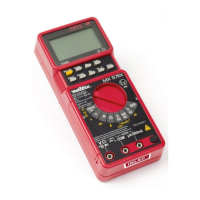X02137C00 - Ed. 1 - 06/07 Chapter II
Intrinsically safe portable digital multimeter
26
∗
For your own safety, only use the measuring probes which have been delivered with the
instrument. Before use, check that they are in good condition.
∗
In an explosive atmosphere, use only accessories that have a certificate of conformity
authorising their use with this multimeter.
1.1.3. During use
∗
When the multimeter is linked to measurement circuits, do not touch unused
terminals.
∗
When the scale of the value to be measured is unknown, check that the scale
initially set on the multimeter is the highest possible or, wherever possible, choose
the autoranging mode.
∗
Before changing functions, disconnect the test leads from the circuit under test.
∗
When performing current measurements, never change of range, do not connect or
disconnect leads without first isolating the current. If you do, there is a risk of
generating surge currents which can blow the fuse or damage the instrument.
∗
Never perform resistance measurements on live circuits.
1.1.4. Symbols
Warning: Risk of danger. Refer to the operating manual to find out the nature of the
potential hazards and the action necessary to avoid such hazards.
Earth
Dual insulation
According to WEEE directive 2002/96/EC
1.1.5.
Definition of measurement categories
CAT III: Measurement category III corresponds to measurements on building
installations.
Example: measurements on distribution panels, cabling, etc.
1.1.6. Opening the instrument (performed outside explosive atmosphere only)
∗
Before opening the instrument, always disconnect from all sources of electric
current and make sure not to be loaded with static electricity, which may destroy
internal components.
∗
The F1 fuse certified for EX classified danger zones, as well as the F2 fuse, must
be replaced by a model identical to the origin fuses.
(See §. 3.5.3. Replacing the battery or one fuse).
∗ Any adjustment, maintenance or repair work carried out on the multimeter should
be carried out only by appropriately qualified personnel, after having taken into
account the instructions in this present manual. A "qualified person" is one who
is familiar with the installation, construction and operation of the equipment and the
hazards involved.
This qualified person must be familiar with equipment for explosive atmospheres
and be trained in the general rules for intrinsic safety.
∗
When the instrument is open, for maintenance purposes for example, remember
that some internal capacitors can retain a dangerous potential even after the
instrument is powered down.

